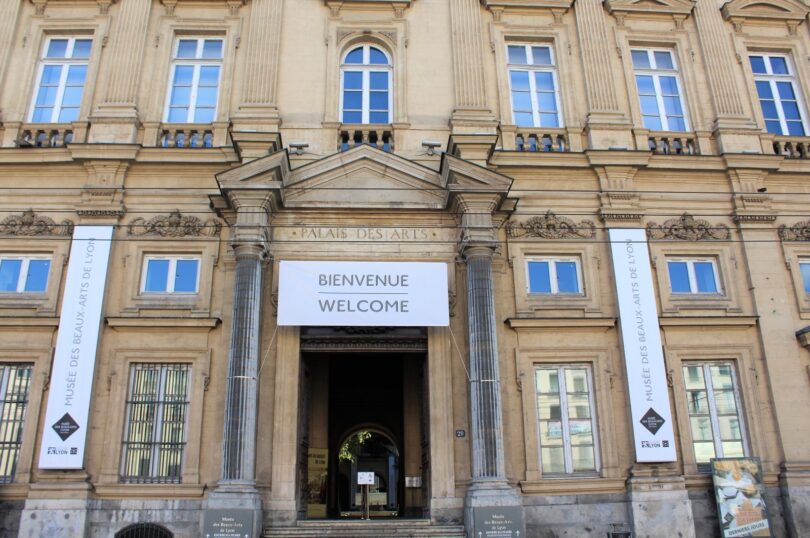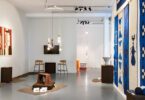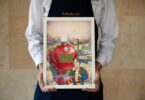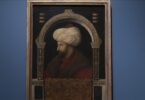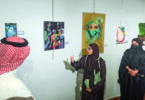A. Peter Dore
The Museum of Fine Arts in Lyon’s collection of Near Eastern artifacts eloquently showcases the intricate tapestry of Islamic cultures, from Arabic lamps embodying prayer to Persian ceramics portraying deep love and Turkish plates harmonizing creative unity, all reflecting the interwoven complexities of aesthetics, religion and symbolism across history
Here I want to complete my review of the Near Eastern artifacts of The Museum of Fine Arts (Musée des Beaux-Arts) in the French city of Lyon with a piece on some of the Islamic art from this region that it displays. All the featured works are from a permanent exhibition space in the museum that is located on its first floor. I have chosen here from among the Arabic, Persian and Turkish artifacts.
The works in this piece necessarily raise the issue of what the expert in Islamic art, David Talbot Rice, refers to as “the ban on representation of living figures, which is generally believed to be a characteristic of Islamic art.”
The Arabic and Turkish works I have selected feature no human or animal figures, whereas two of the Persian pieces feature both. I do not feel it is my place to touch on the theological issue here, I wish merely to point out that it is a historical fact that this ban was not, as Talbot Rice notes, “ever universally enforced with regard to secular art in later times” or at the beginning of the hereditary caliphates.
The Persian works that I have chosen are certainly secular, though, as I will demonstrate below, a brief look at Persian poetry suggests that one of them could carry a religious meaning as well.
Arabic art
The two Arabic artifacts I have selected both connect to the second of the five pillars of Islam, the ritual prayer that is performed five times daily. Firstly though, I should note that when I initially saw the first item, I thought I had come face-to-face with a familiar friend.
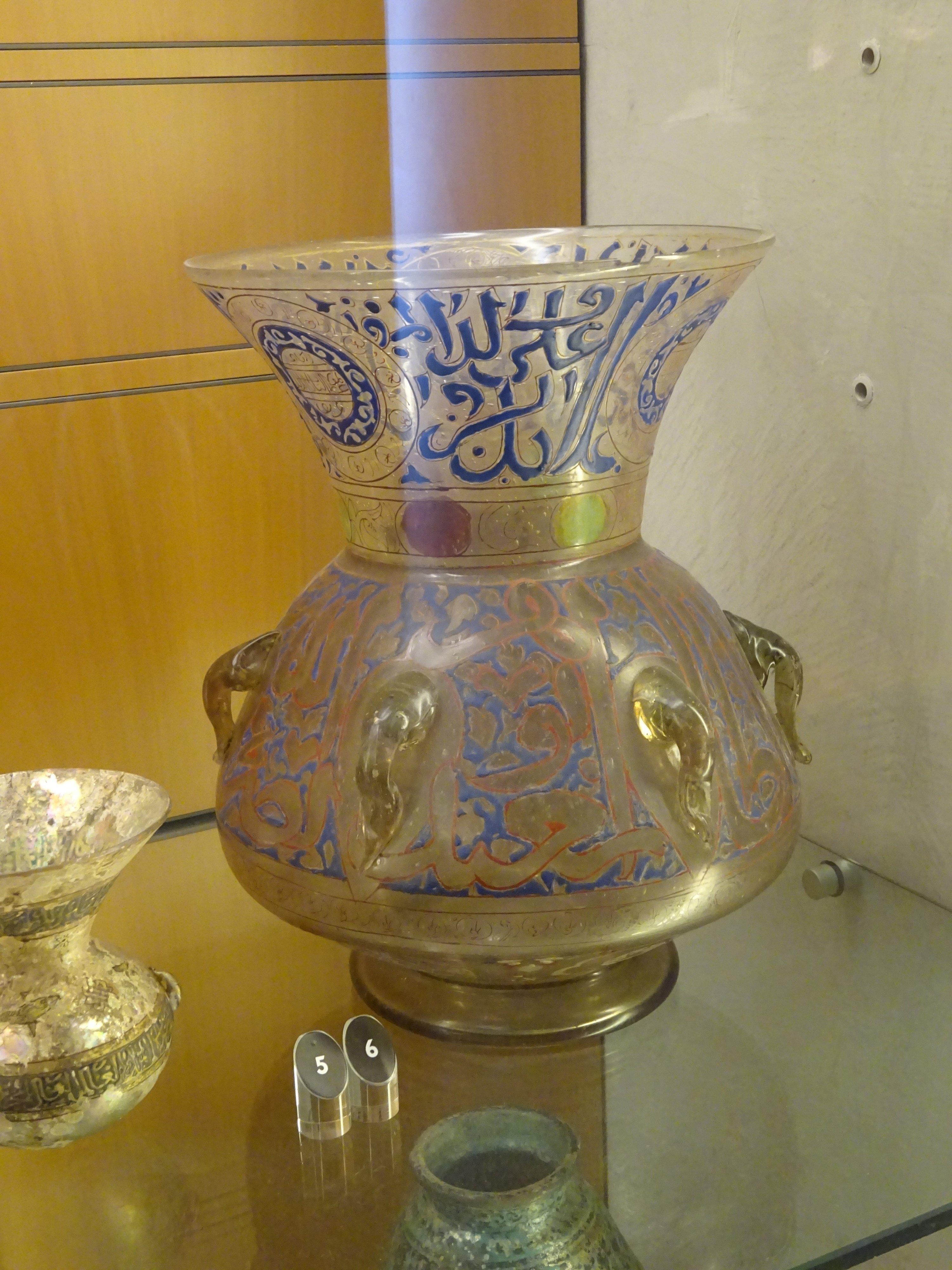
The mosque lamps looked like the ones decorating the cover of my copy of “A History of the Arab Peoples” by Albert Hourani; however, they are in fact slightly different. Yet, they both come from Egypt, they are both 14th-century works, and both were commissioned by leading figures in the state. They belong to what Martin Birk Moller calls “the golden age of Islamic glass art.”
Moreover, Talbot Rice regards their specific type of glasswork, known as enameled glass, as being at the apogee of all Islamic glasswork, and these lamps being the apogee of enameled glasswork, with the best examples being produced in Egypt or Syria. The Lyon piece was made for the Mamluk Egyptian Sultan Barquq, who was obviously a keen connoisseur of these exquisite items as 59 lamps commissioned for him survive even to the present day.
As a mosque lamp it would have been filled with olive oil, hung from the six regular holed projections on its side, and a taper lit in it so that it would cast its gentle light over the congregated believers in the mosque for the three prayers that are not performed during daylight, namely those of the evening, night and dawn. It makes one think of Kang Youwei’s remark about the “countless … oil lamps” hanging over the believers in Hagia Sophia, showing how this tradition continued down into the 20th century when it was replaced by electric lighting.
Before a Muslim is able to pray, however, they must do a ritual ablution. If they pray at home, in the time before the advent of indoor plumbing, they would use a jug or a ewer. In the Lyon museum, there is a particularly eye-catching gilded silver ewer, embossed with Thuluth calligraphy, a style that would be developed in the Ottoman Empire.
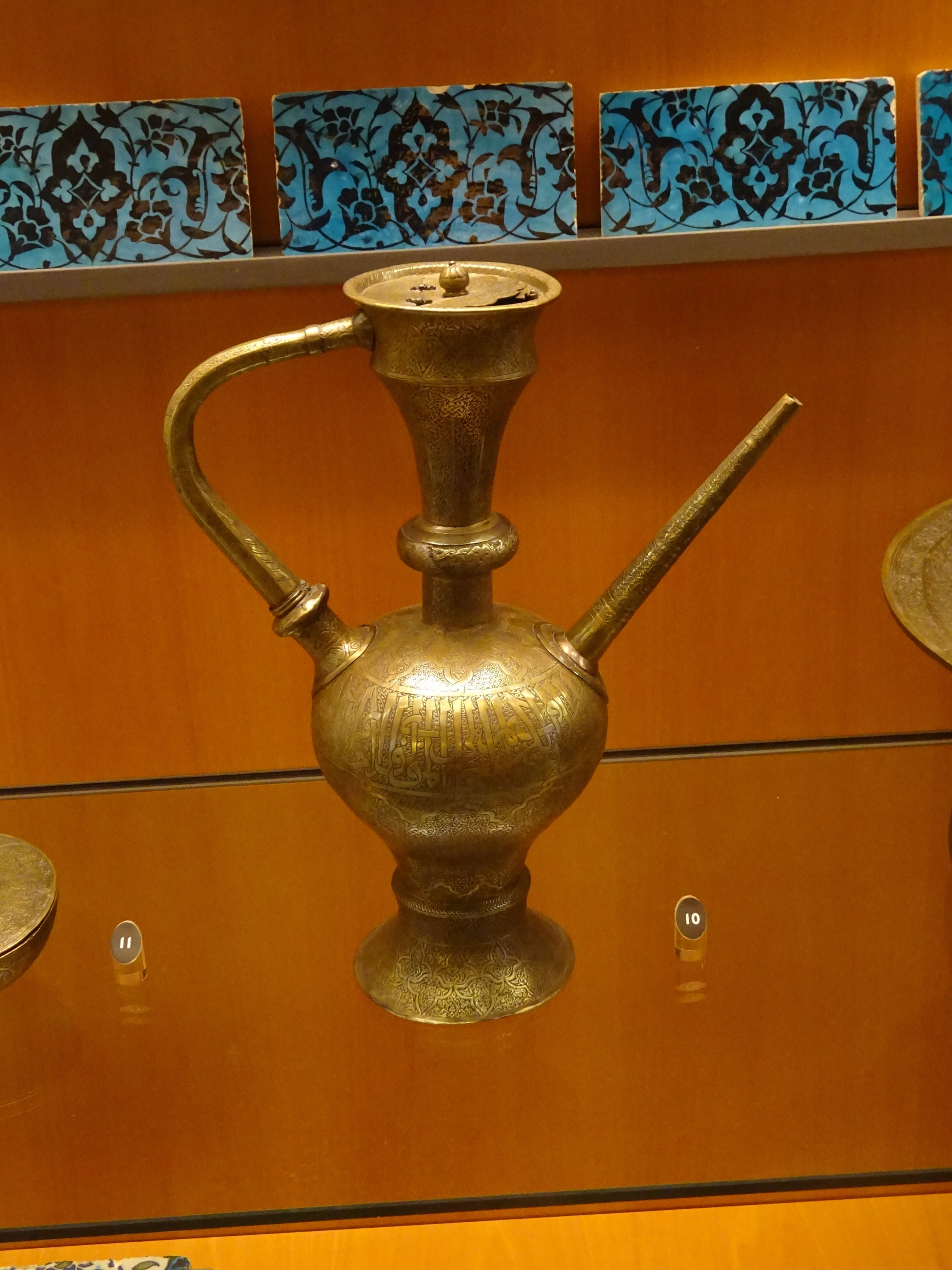
This ewer also belonged to an elite Egyptian from the Mamluk era, the Emir Gawhar al-Mu’ini, although it is a century later than the lamp. It is perhaps a symbolic piece in that though an emir, Gawhar al-Mu’ini would also have been the sultan’s cupbearer. With its sleek and stark lines, it has an air of urgency about it which, for me, is amplified by the handle which suggests an arm impatiently grasping its hip. Thus, the whole work seems to be encouraging the believer to be timely and not tardy in preparing for their devotions.
Before moving on to the Persian artworks in the Lyon Museum, I would here like to express my thanks to Othob Alzaidi who has helped me with these Arabic items.
Persian art
In the section on Persian art, the 19th-century pen case would have failed to attract my attention but for its literary association. Yet, the deeply troubled narrator of Sadegh Hedayat’s “The Blind Owl,” one of my all-time favorite books, is a Persian pen case illustrator, so this piece in Lyon caught my eye. It is true that the depiction upon it is not, as in Hedayat, of a young woman clad in black under a cypress tree offering a flower to a man bent up beneath it.
Nevertheless, its similarity to the one related to Hedayat’s novella is remarkable. Both feature a woman, whose, in Hedayat’s words, “beauty” is “extraordinary,” with an enigmatic smile, thick black hair and arresting eyebrows over hypnotic eyes. Moreover, while she is not directly under a cypress tree, there are trees including cypresses, framing the picture at the top.

Next to the pen case cover is a floral book cover. Nevertheless, there is a more exquisite work from a similar time and type nearby. This is labeled as “Leaves of a Shutter” and at a mere 47.4 by 37.4 centimeters it must have acted as a shutter for a mirror. It is wooden and has been painted and gilded.
It is simply a masterpiece of decorative art. Contrast has been used in the two main background colors of scarlet red and navy blue to heighten the effect of both, and draw one’s eye immediately to the curved heart of the piece that has some kinship in shape to that of the dome of an Iranian mosque.
Atop these background colors is the lavish floral decoration, with different kinds of flowers in a naturalistic style. Their colors are harmonious both with each other and the background which is a difficult effect to achieve when so many different ones are involved. The word beautiful seems off for a piece as daintily produced as this. Calling it supremely pretty conveys its sense better.
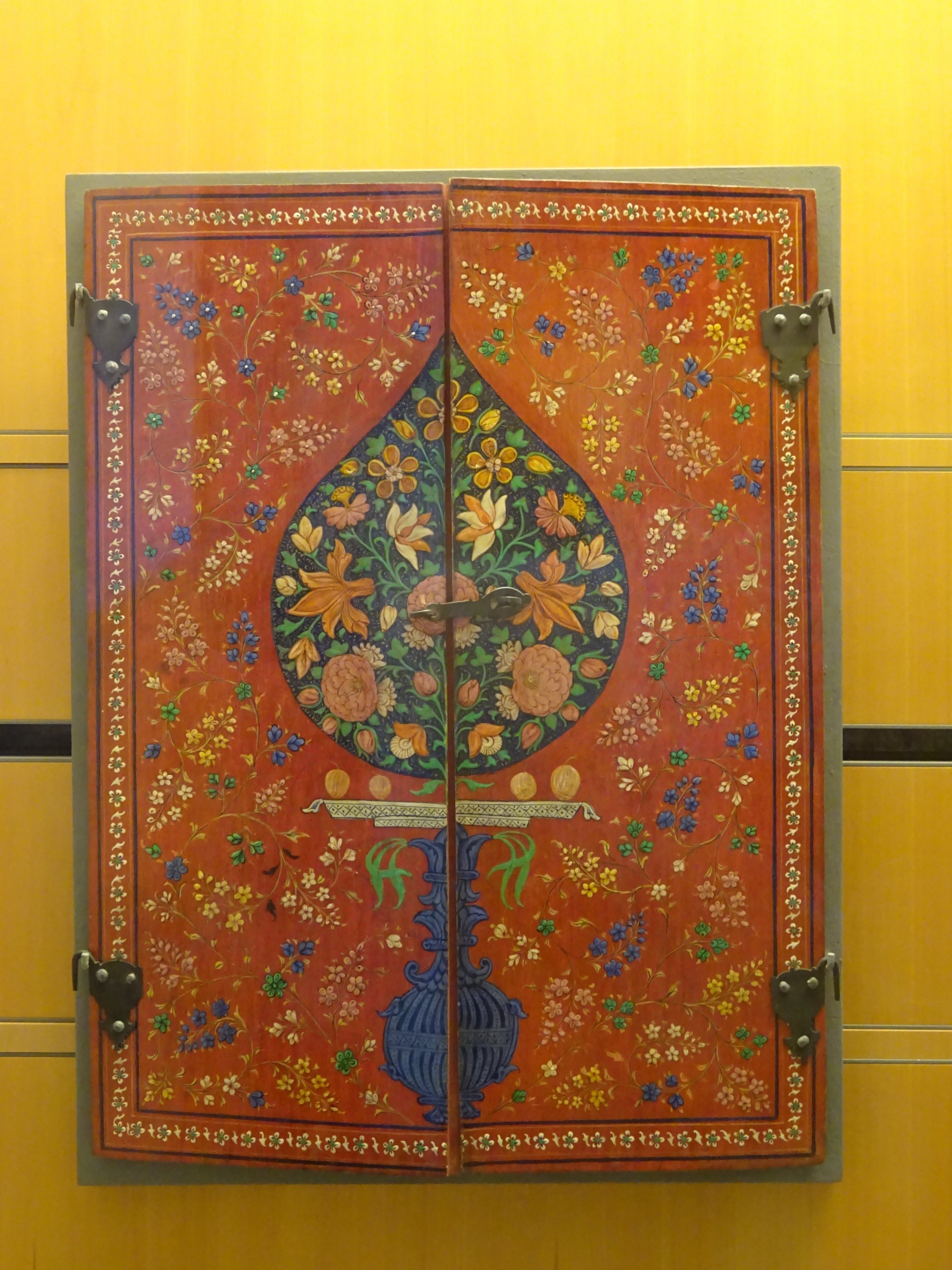
There is also a ceramic piece on display here. It is labeled “A Horseman and a Horsewoman” and it is a 19th-century tile from Tehran. It depicts two lovers courteously meeting on horseback. Although they incline their heads bashfully away from one another, they only have eyes for one another.
The inclination of the woman under her dainty parasol is more pronounced because, in Persian art, a coy tilting of a woman’s head betokens that she is in love. This coyness does not incapacitate her, however, since she is also holding her right hand out to him.
Love has blinded them to all else around them, be it their animal companions such as the little dog yapping to get its master’s attention or their mounts that seem also to be involved in flirtatious activity, thus intensifying the overall theme of the piece.
What is more, the human lovers have their heads inclined away from what are homes or palaces and a mosque or shrine, the concerns of the material or spiritual life being washed away in a sea of love, the metaphor of the sea suggested by the deep blue background to the piece.
This suggests the way in which the key theme of Persian poetry, the exclusiveness of love, is portrayed. A well-known tale in Farid ud-Din Attar’s “The Conference of the Birds” is about a highly respected sheikh who is suddenly smitten when he catches sight of a Christian princess.
The violence of his passion causes him to undergo a radical change of character. He turns away from all he had been before and even gives up “religion’s wealth for shame” in that he abandons all of his former pious practices to wallow in the dust before this woman’s home, as his love for her has become all to him. Yet, the issue of love in Persian poetry is more complex than it may at first appear.
The general interpretation is that the human love it shows is a metaphor for the absolute love a true believer ought to feel for God. Thus, this ceramic could also be read metaphorically as a religious piece.

Turkish Art
Before moving on to Turkish works, I would like to make a point that may enhance their appreciation. It is that while many art forms are based upon rules, if there is a sufficient degree of creativity in the artist then within these rules a great deal of imaginative variation can still emerge.
All of the plates that I will deal with here are, save perhaps the first, 16th-century pieces from Iznik in Türkiye and they were produced with an understanding of design rules concerning motifs. Ernst J. Grube argues that these “motifs are almost exclusively floral, realistic, and particularly sensitive in design.”
I take issue with the idea that the flowers on the plates are “realistic” and incline more to the view of Simon Trethewey who states: “The flower forms, although occasionally recognizable as the rose or tulip or others are generally not of a type that exists in this world. The intention was to take the motif away from the particularity of an individual flower and to move it closer to an archetypal form, one more reminiscent of the unity behind all flowers.”
Despite the disagreement, the rule pertaining to Iznik pottery is that the designs be floral. They are also polychromatic, though this tends to be within a relatively limited color palate. This still allows for each plate to be very much an individual work of art, presumably reflecting the perspective of its maker.
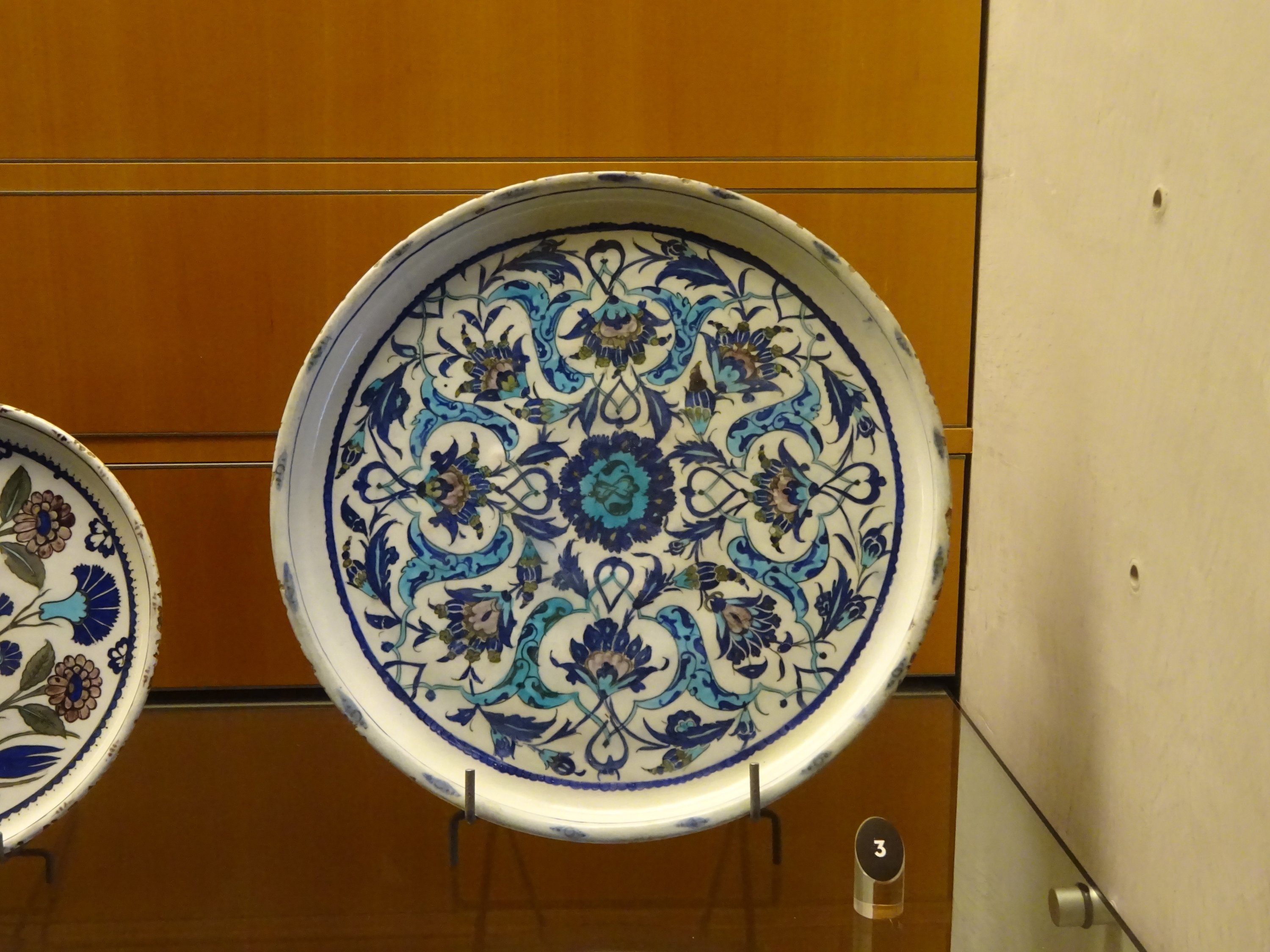
The first plate that I will examine is called “Plate Decorated with Flowers and Radiating Petals.” In its design, despite its cool blue color, the flower in the center seems to resemble the sun pulsing with energy. Then there are the eight symmetrical radiating petals with their continuity in color which resemble the rays of the sun, carriers of its beneficent heat and life-giving powers.
Moreover, their indication of the cardinal compass points makes a further connection with the sun, these points on Earth being determined by it. All in all, this explains why when looking at the plate, one feels a sense of warmth rather than the cold that one would associate with this dominance of blue. The whole piece can also be regarded as symbolic of divine grace reaching out over all of creation.
A nearby plate is labeled as “Plate Decorated with Roses and Cypresses.” In terms of color and its white spaces, it makes one think of Piet Mondrian. Yet, in its limitation to the three primary colors of red, green and blue, Mondrian would use yellow in place of green.
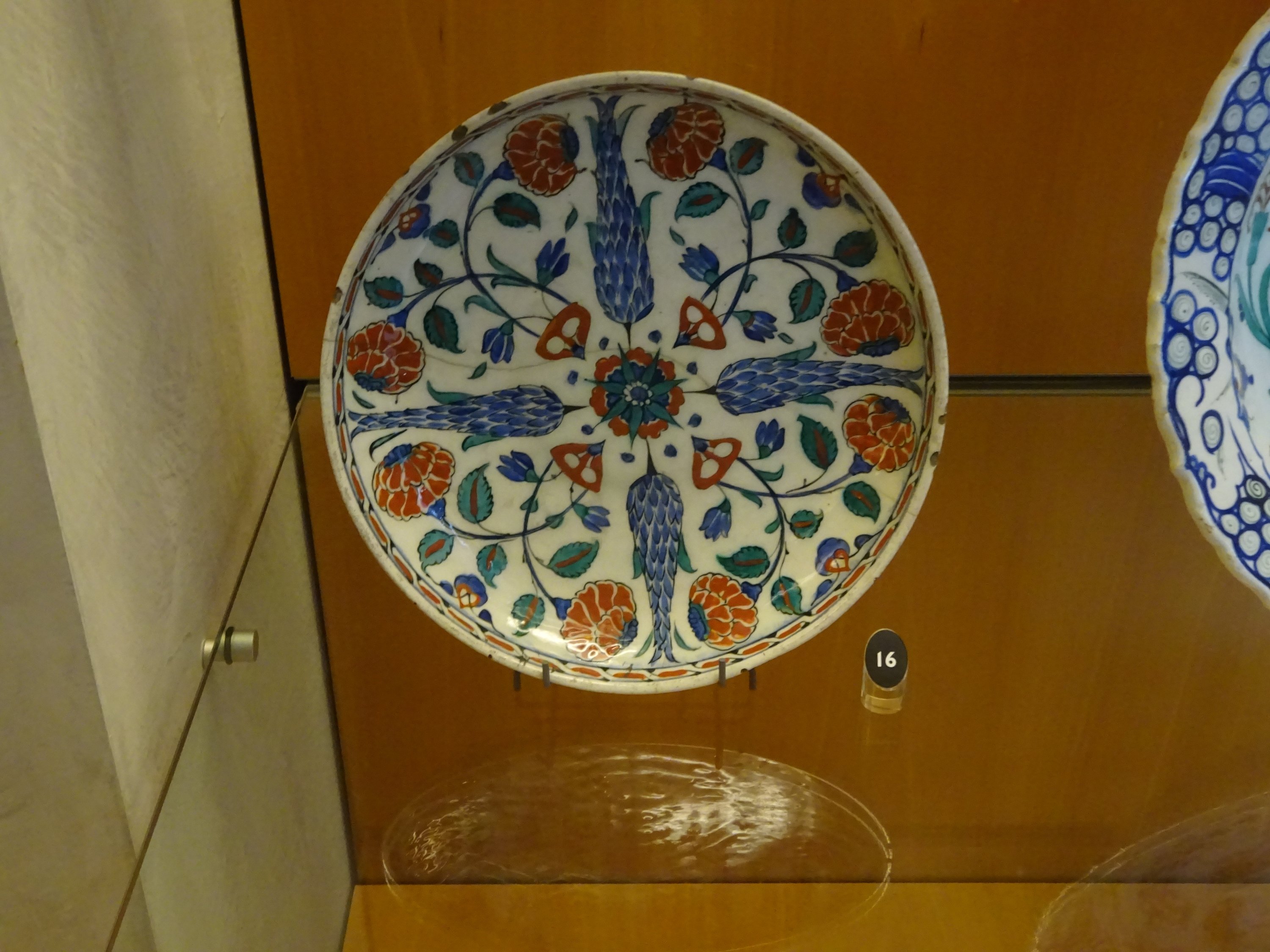
It is the most geometric of the works on display here. Reflecting a strong concern for symmetry, this plate is clearly divided into quarters by the turquoise cypresses the stems of whose bases spring out of the central rose. Although the images on the plate are obviously botanical, in no way are they depicted as individual manifestations but rather they are reduced to a type, their fundamental essence, much like the goal to which Mondrian strives.
In comparison with the other plates on display here, this is the most austere. It has a very controlled feeling to it and despite its nominal use of plant life, it makes no real concession to the messiness of botanical nature, seeking its inspiration instead from metaphysical perfection. I would imagine that the artist of this plate is motivated by powerful yet simple religious feelings.
In one sense, the nearby plate entitled “Concave Plate with a Central Bouquet” is similar to it, in that it too uses the same limited colors and much of the plate is undecorated in any way. Nevertheless, this plate celebrates nature and life in its diversity. This does not, of course, mean that aspersions should be cast as to the relative piety of its artist vis-a-vis that of one of the previous plates. In this case, by celebrating creation this piece can easily be read as glorifying the Creator.
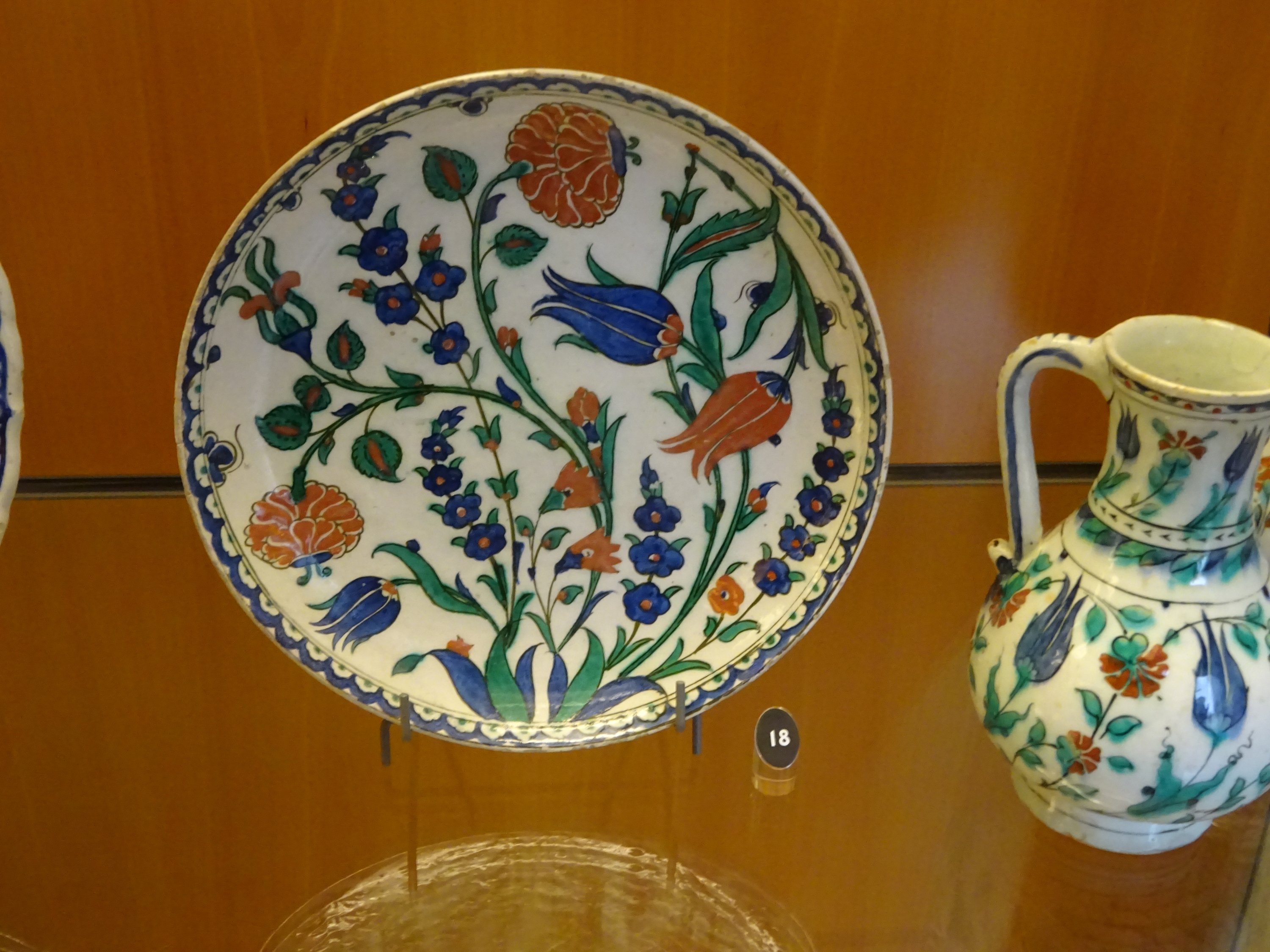
It does this by representing more flower types and the blooms as individualized flowers. Moreover, with the same flower shown as a bud and bloom it also depicts change, the essence of life. Furthermore, some flowers cross over others, which also symbolizes life with its complex entanglements.
The Islamic taboo on the depiction of human life has, along with the other plates in this collection, been strictly adhered to here. Yet, I cannot help but see something of an anthropomorphic spirit on this plate. The five largest flowers are not simply individualized, they also appear human-like.
In the case of the tulips on the left, they seem to possess a sense of inquisitiveness, casting a shaded eye over what is going on in front of them. As for the rose at the top, it appears to want to be left alone in peace as it has turned its back, or stem, on everything. The small blue tulip on the right looks as if it has met up with the other rose as far away as possible from the others in order to have a private conversation out of earshot, with the rose perhaps attempting to force the shy and reluctant tulip to engage in a bit of talk.
The final plate I want to look at is called “Plate of Carnations and Hyacinths.” Although the plate itself is presumably as sturdy as all the others, the small blue hyacinths as well as the use of a light watery green for the stems give it an air of great delicacy. Moreover, bold domineering reds are almost completely absent from this plate. Indeed, their limited use seems to be to increase the impact of the blue through the use of contrast.
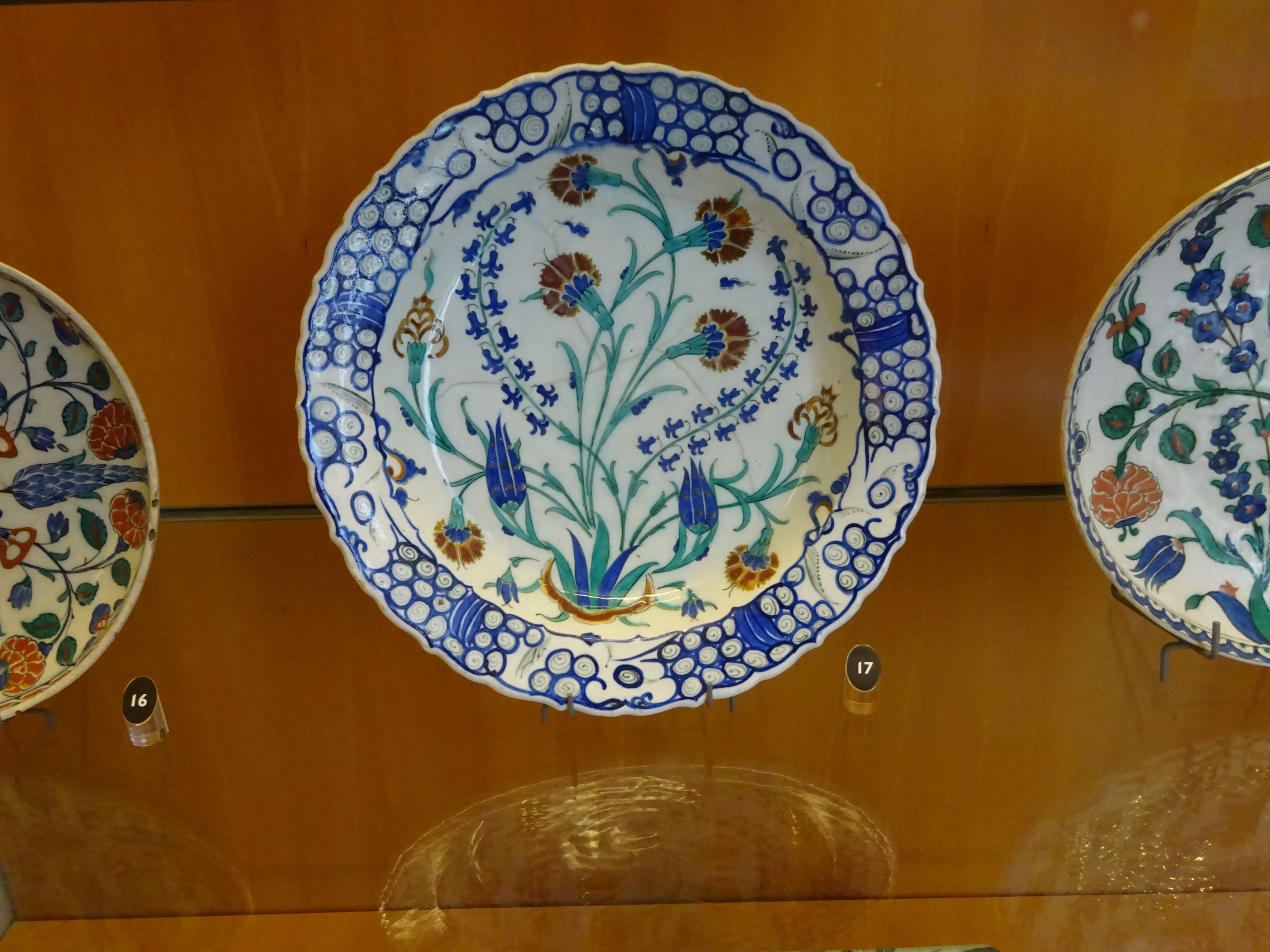
Although there are four downward-looking flowers at the bottom of the plate, two of them are miniscule and the clear direction of movement in this plate is upward. The blue tulips at the bottom of the plate stridently point toward the top. This suggests that they are striving for heaven. Then, the hyacinths on their reedy stems appear as a pair of arms stretching upward but also embracing the carnations between them.
This suggests the idea that in reaching up for the Divine, it is necessitated that the fate of others must also be attended to. The carnations, the flowers that have come closest to the top of the plate, have turned their gazes aside as if such proximity to the Creator is more than their souls can bear and they have to humbly turn away.
The Iznik plates on display in the Lyon Museum demonstrate a multiplicity within uniformity that is also manifested in the other works. As such, all of these works are representative not only of the art of the religious culture in which they were produced but also of that culture itself.
Courtesy: Dailysabah

